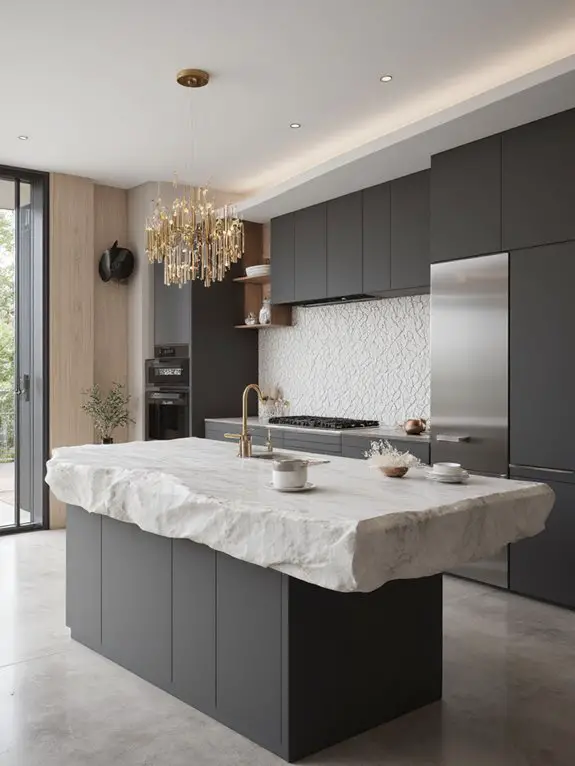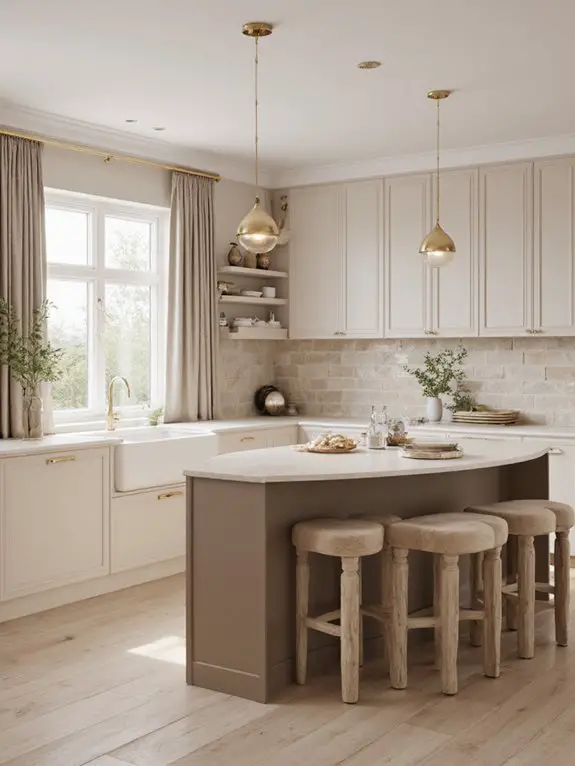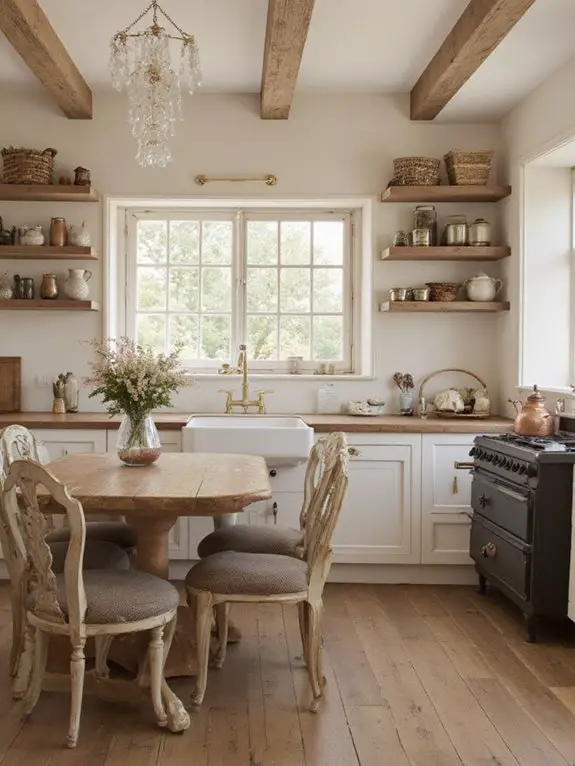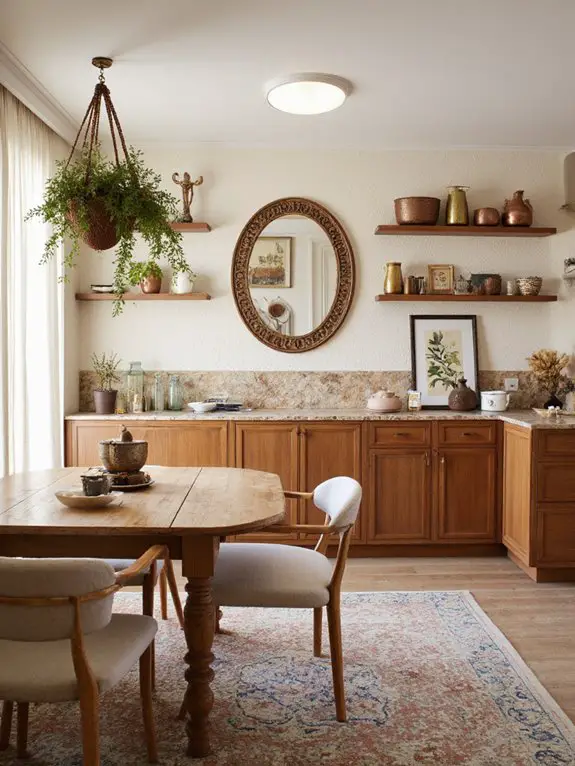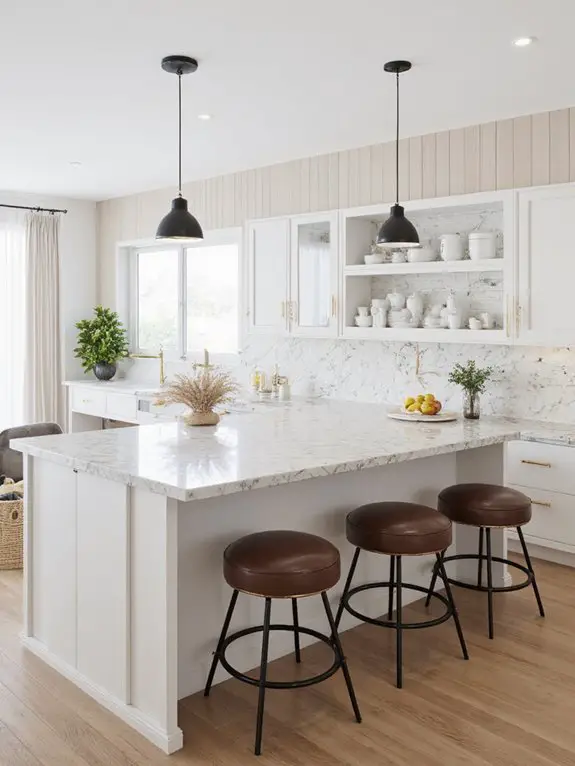I’ve found that open-concept layouts, minimalist cabinets, and smart appliances are transforming modern kitchens into sleek, functional spaces. Two-tone designs and open shelving add depth without clutter, while quartz or marble countertops offer durability and elegance. Statement backsplashes and handleless cabinetry create a streamlined look, and seamless indoor-outdoor connections make entertaining effortless. These ideas balance style and practicality for a kitchen you’ll love. Exploring further reveals even more ways to elevate your space.
Open-Concept Kitchen Layouts
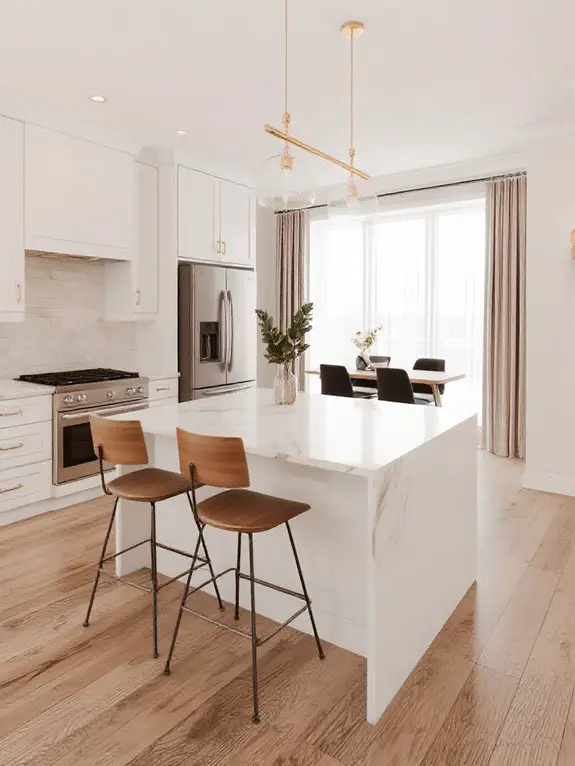
If you’re considering a kitchen redesign, I’d recommend exploring open-concept layouts because they’ve become a popular choice for modern homes. They create a seamless flow between the kitchen, dining, and living areas, making the space feel larger and more connected.
I’ve found this design perfect for entertaining, as it allows me to interact with guests while cooking. Removing walls also maximizes natural light, brightening the entire area.
To make it work, I suggest aligning the kitchen’s aesthetic with the adjacent spaces for visual harmony. Consider strategic placement of islands or counters to define zones without disrupting the openness. It’s a practical and inviting upgrade.
Minimalist Kitchen Cabinets
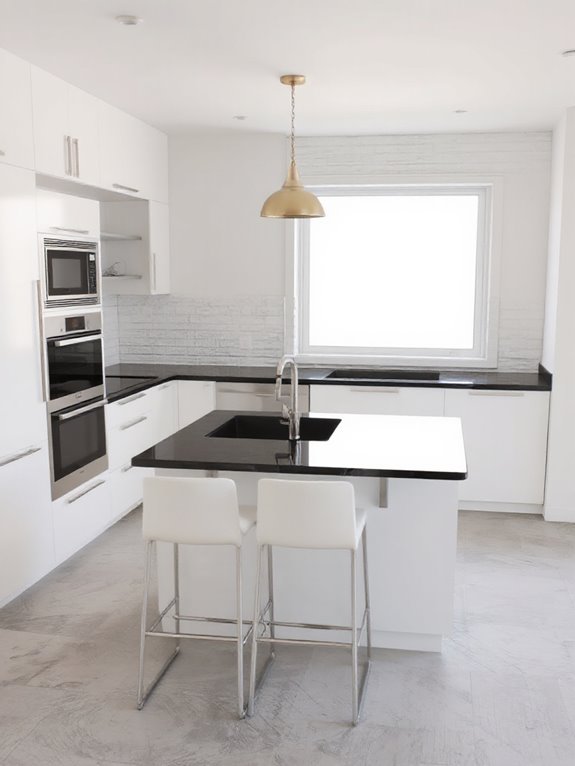
Open-concept kitchens often benefit from a clean, uncluttered aesthetic, and minimalist kitchen cabinets are a natural fit for achieving this look. I love how streamlined designs with flat, handleless fronts create a seamless appearance, making the space feel larger and more cohesive.
Opting for neutral tones like white, gray, or soft wood finishes enhances this effect, allowing natural light to bounce around the room. For functionality, I recommend maximizing storage with pull-out drawers and hidden compartments.
Minimalist cabinets aren’t just about looks; they’re practical too, keeping essentials within reach while maintaining a calm, organized environment. It’s simplicity at its best.
Smart Kitchen Appliances
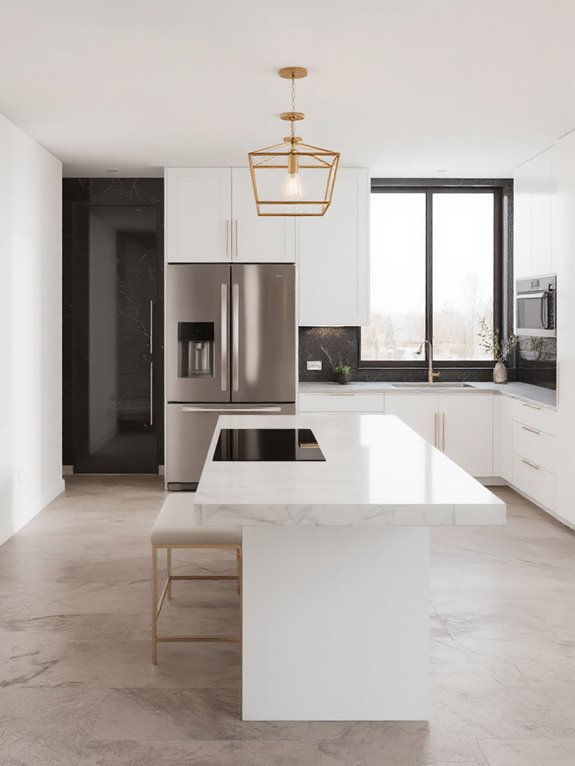
As someone who’s always looking for ways to make daily tasks easier, I’ve found smart kitchen appliances to be a game-changer. From Wi-Fi-enabled ovens that let me preheat remotely to refrigerators that track expiration dates, these devices streamline meal prep and reduce waste.
I love how voice-activated assistants sync with my appliances, so I can adjust settings hands-free. Smart coffee makers brewing my morning cup before I’m out of bed? Yes, please.
They’re not just convenient—they’re energy-efficient too, helping me save on bills. Investing in these gadgets has transformed my kitchen into a functional, modern space that works smarter, not harder.
Statement Backsplashes
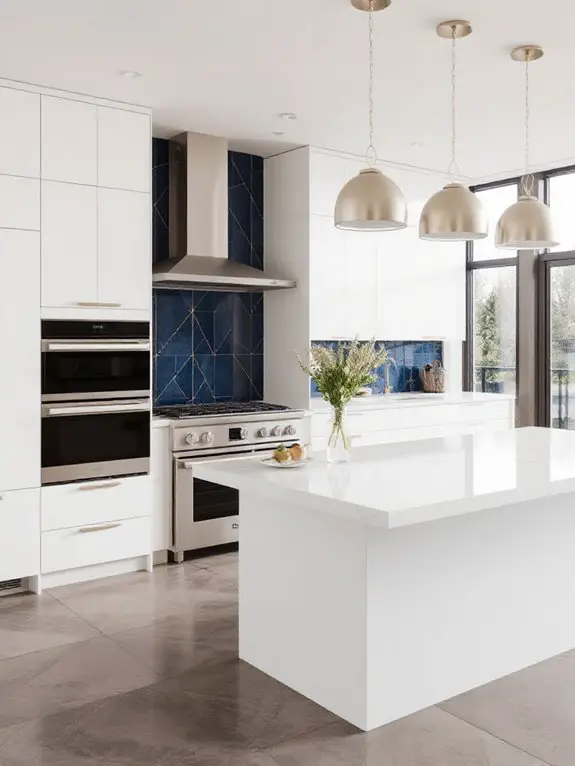
While smart appliances bring efficiency to the kitchen, a statement backsplash can elevate its style with bold personality. I love how a visually striking material, like hand-painted tiles or metallic finishes, becomes the focal point of the space.
It’s not just about aesthetics—durable materials like glass or porcelain guarantee it’s practical for daily use. I often recommend extending the backsplash to the ceiling for a dramatic effect or pairing bold patterns with neutral cabinets for balance.
Color choices can set the tone, whether it’s a vibrant pop or a subtle monochrome. A statement backsplash is an investment that transforms the heart of your home.
Sleek Handleless Cabinetry
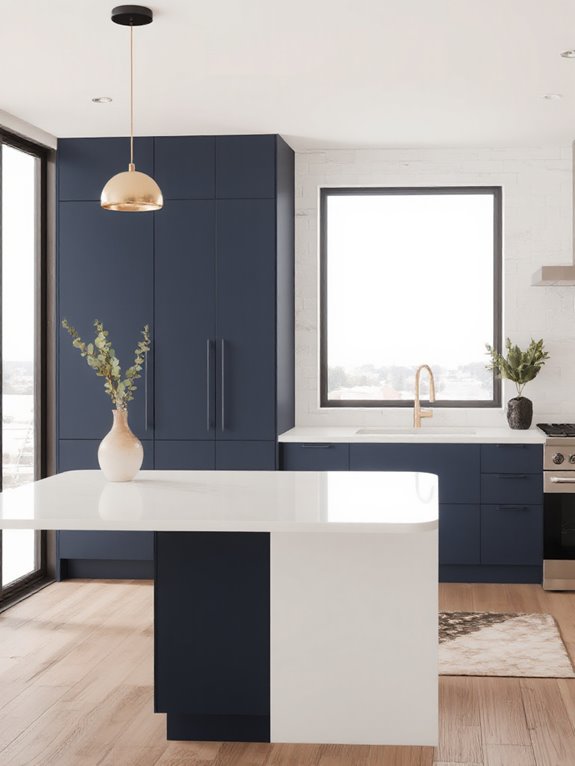
To achieve a clean, minimalist look in your kitchen, sleek handleless cabinetry offers a streamlined solution that blends functionality with modern design. I love how it creates a seamless appearance, giving the space an uncluttered, contemporary feel.
Without visible handles, the cabinetry relies on push-to-open mechanisms or integrated grooves, which simplify the aesthetic. I recommend opting for high-gloss or matte finishes to enhance the modern vibe.
It’s also worth choosing durable materials like laminate or wood for longevity. Handleless designs maximize storage efficiency while maintaining a tidy look, making it perfect for those who value both style and practicality in their kitchen.
Integrated Kitchen Lighting
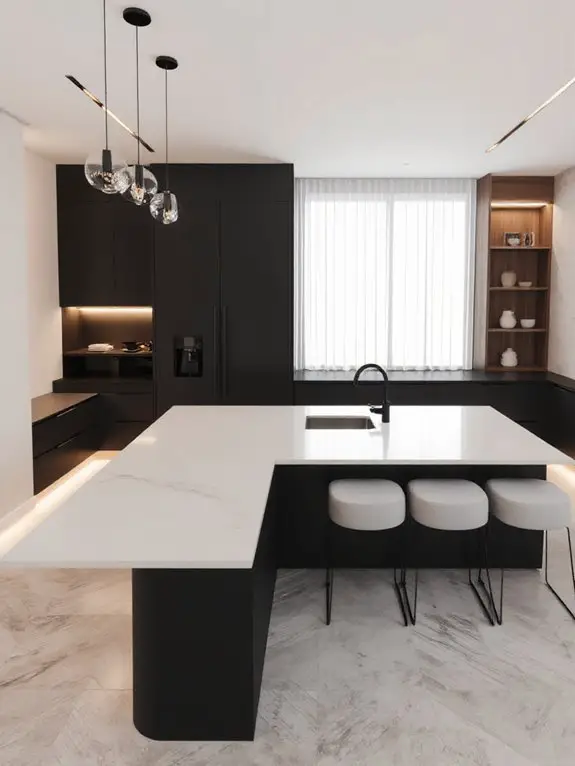
Integrated kitchen lighting seamlessly blends functionality with modern design, transforming the space into a well-lit, cohesive environment. I’ve found that incorporating LED strips under cabinets or within alcoves enhances task lighting while adding a subtle glow.
Recessed ceiling lights provide even illumination without cluttering the aesthetics. Dimmable fixtures are a personal favorite, allowing me to adjust the ambiance for cooking or entertaining.
Pairing ambient, task, and accent lighting creates layers of brightness, making the kitchen both practical and inviting. I recommend choosing lighting that complements your cabinetry and countertops, guaranteeing a harmonious blend.
Thoughtful placement guarantees every corner is functional yet stylish.
Kitchen Islands With Seating
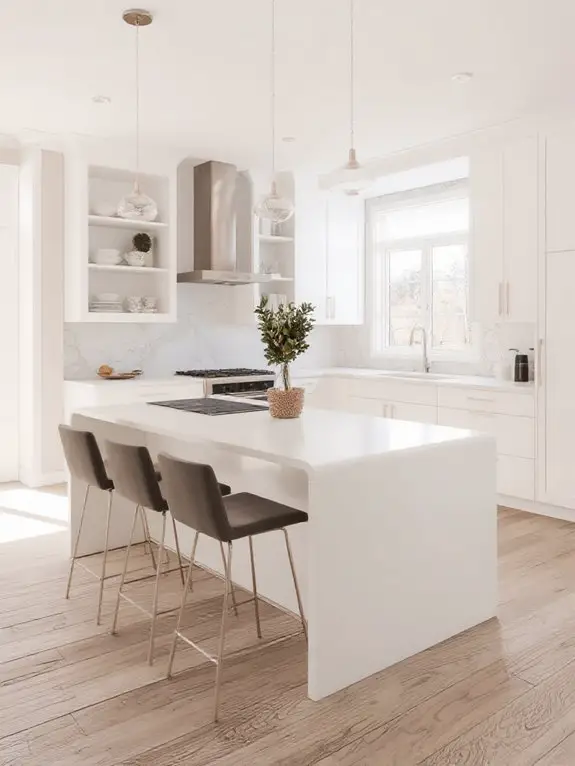
When designing a kitchen island with seating, I’ve found that it’s essential to balance functionality with spatial planning. Start by determining the island’s size relative to your kitchen’s dimensions—overcrowding can hinder movement.
I recommend allowing at least 36 inches of clearance around the island for easy navigation. For seating, calculate 24–30 inches per person to guarantee comfort. Opt for stools with adjustable heights, as they accommodate both casual dining and task-focused work.
Consider extending the countertop overhang by 12–15 inches to provide legroom. Finally, think about the island’s role—whether it’s for meal prep, socializing, or both—to guide its design and placement.
Mixed Material Countertops
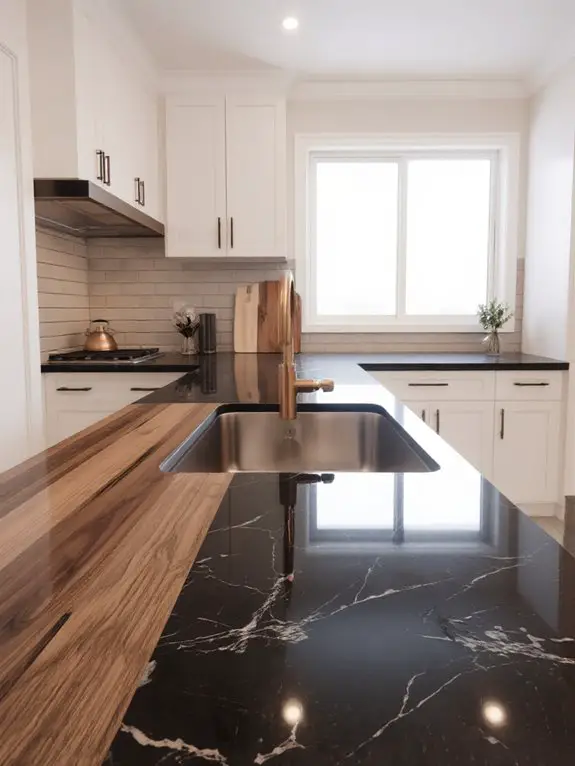
How can you achieve a dynamic yet cohesive look in your kitchen? I’d suggest incorporating mixed material countertops. Combining materials like quartz with butcher block, or marble with stainless steel, adds texture and depth while maintaining harmony. Use one material for prep zones and another for durable work surfaces—it’s both functional and stylish.
I’d choose complementary tones to tie everything together, avoiding clashing colors. For instance, pairing warm wood with cool stone creates balance. Keep the overall design streamlined by limiting materials to two or three. This approach elevates your kitchen’s aesthetic without overwhelming the space, making it both functional and visually striking.
Glass-Front Cabinets
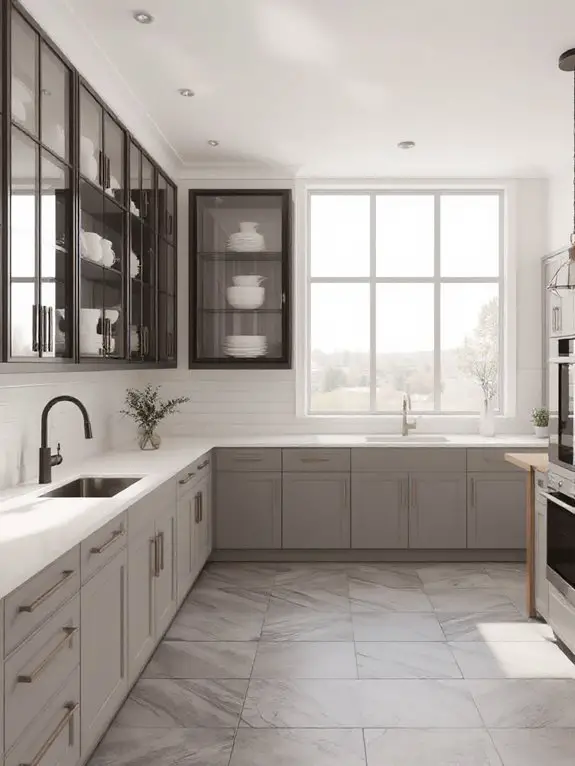
Glass-front cabinets can transform your kitchen by adding openness and a touch of elegance. I’ve found they’re perfect for showcasing beautiful dishes or glassware, making your space feel curated and intentional. They’re also great for smaller kitchens, as they create an illusion of depth without overwhelming the room.
When choosing glass styles, I prefer frosted or textured options if I want to hide clutter, while clear glass works for displaying neatly organized items. Pairing them with LED lighting inside the cabinets enhances their visual appeal, especially in the evenings.
They’re a simple upgrade that delivers both functionality and style effortlessly.
Bold Kitchen Color Schemes
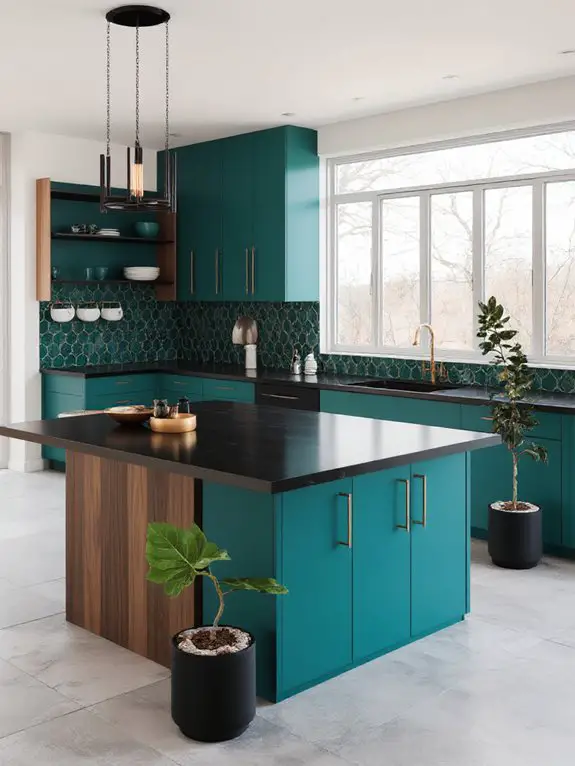
While neutral kitchens have their appeal, bold color schemes can inject personality and energy into your space, turning it into a striking focal point. I’d suggest starting with vibrant hues like deep emerald, rich navy, or sunny yellow, but balance them with neutral tones to avoid overwhelming the room.
Consider painting cabinets or an accent wall for a dramatic yet manageable impact. Pair bold colors with sleek materials like matte black hardware or polished concrete countertops to create a modern edge.
Lighting also plays a key role—opt for warm fixtures to soften intense shades, ensuring the space feels both lively and inviting.
Compact Kitchen Storage Solutions
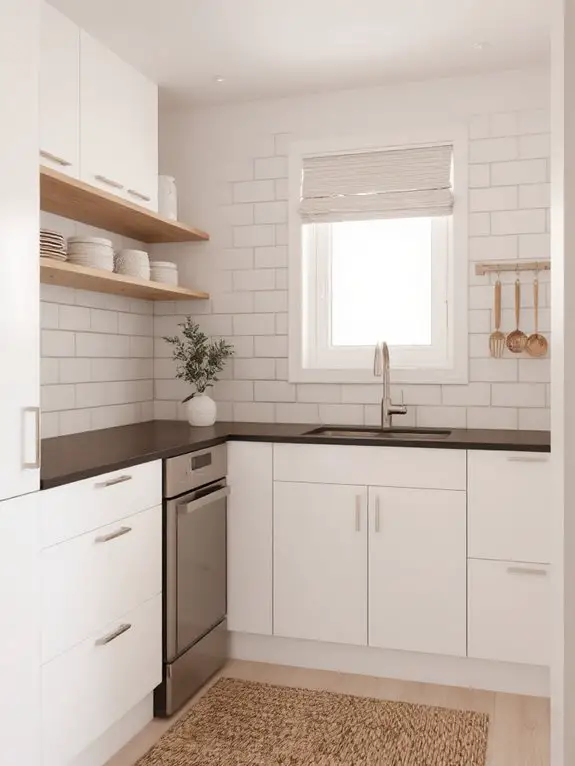
Even though space may be limited, compact kitchen storage solutions can transform cluttered areas into highly functional and organized spaces. I’ve found that utilizing vertical spaces with wall-mounted racks for spices, utensils, or cutting boards maximizes every inch.
Pull-out drawers and shelves inside cabinets keep essentials accessible yet out of sight, while magnetic strips for knives or tools save counter space. I also recommend stackable containers for pantry items and nesting bowls for versatile use.
Over-the-sink drying racks or foldable counter extensions are game-changers for small kitchens. With thoughtful planning, even the tiniest kitchen can feel spacious and efficient.
Floor-to-Ceiling Pantry Units
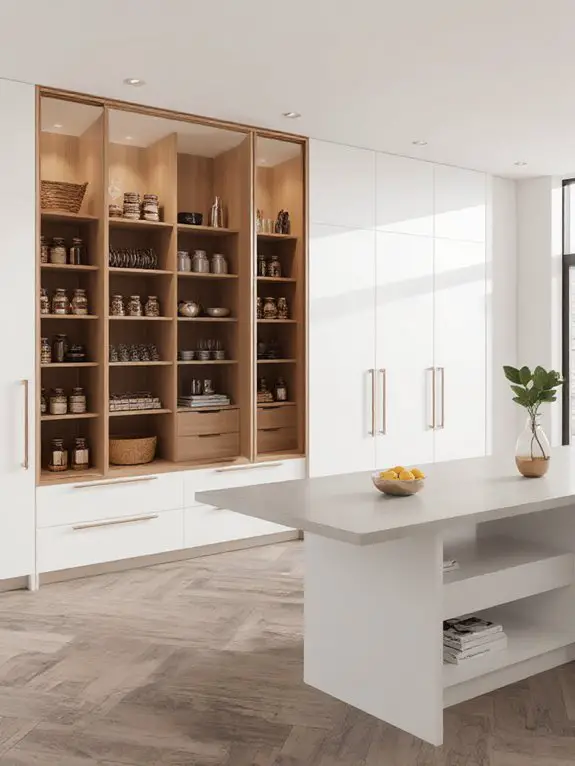
Building on the idea of maximizing kitchen storage, floor-to-ceiling pantry units offer a seamless way to organize and streamline your cooking space. I love how these units make use of every inch of vertical space, eliminating wasted areas while keeping essentials within reach.
Adjustable shelves and pull-out drawers allow me to customize storage for canned goods, baking supplies, or small appliances. I prefer sleek, handle-less designs that blend with modern cabinetry for a cohesive look.
Installing glass-front doors adds transparency, making it easy to locate items quickly. These units are a game-changer for decluttering and creating a functional, visually appealing kitchen.
Contemporary Kitchen Shelving
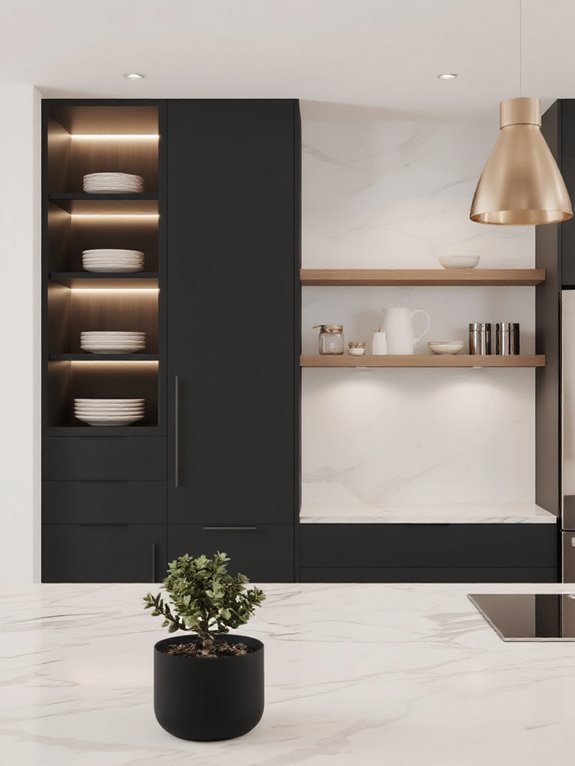
Contemporary kitchen shelving transforms both functionality and aesthetics, offering an open, airy alternative to traditional upper cabinets. I love how it allows me to showcase my favorite dishes or spices while keeping them easily accessible.
Floating shelves made of materials like wood, metal, or glass add a sleek, modern touch. I recommend keeping them clutter-free by styling them with a mix of practical items and decorative accents.
For durability, I opt for sturdy brackets or hidden supports. Open shelving also encourages me to stay organized, as everything is on display. It’s a practical yet stylish way to personalize my kitchen space.
Industrial Kitchen Design Elements
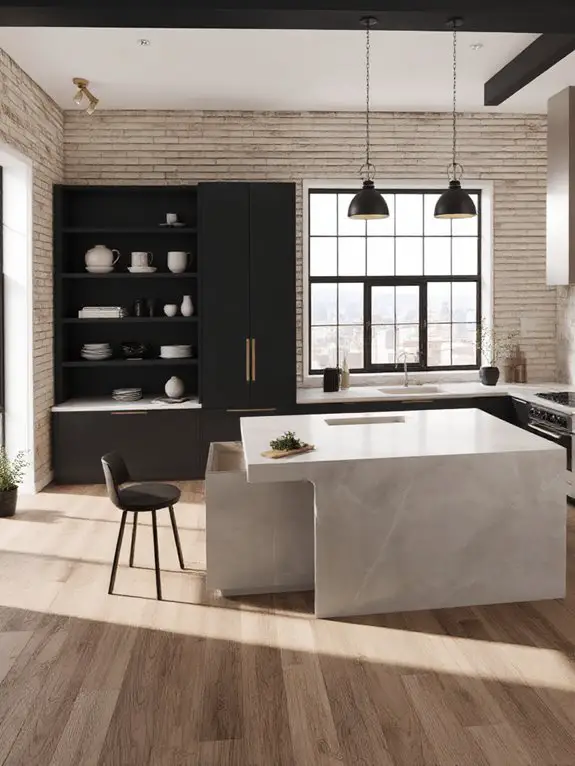
While industrial kitchen design might seem stark at first glance, I’ve found it’s actually a perfect blend of raw functionality and bold style. Exposed brick walls, concrete countertops, and stainless steel appliances are staples that bring an urban edge while being incredibly durable.
I love incorporating open shelving made of reclaimed wood for warmth and texture. Metal accents, like pendant lighting with wire cages or black iron fixtures, add contrast and character.
To balance the hardness, I recommend softer elements like linen textiles or neutral rugs. Industrial kitchens thrive on simplicity, so keep clutter minimal for a sleek, purposeful vibe.
Multi-Functional Kitchen Spaces
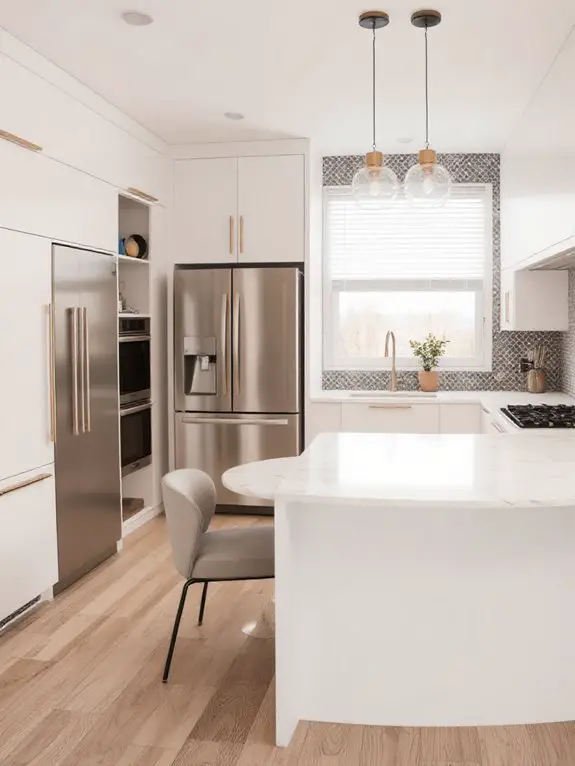
As kitchens evolve into central hubs for more than just cooking, multi-functional spaces have become essential for modern living. I’ve found that incorporating versatile elements like an island with built-in seating transforms my kitchen into a dining area or workspace.
Open shelving paired with a breakfast nook creates a cozy spot for morning coffee. I also prioritize storage solutions like pull-out pantry racks to keep the space organized.
Lighting plays a key role—adjustable pendant lights shift the mood for different activities. By blending practicality with design, my kitchen now seamlessly accommodates cooking, entertaining, and daily tasks without feeling cluttered.
Hidden Kitchen Appliances
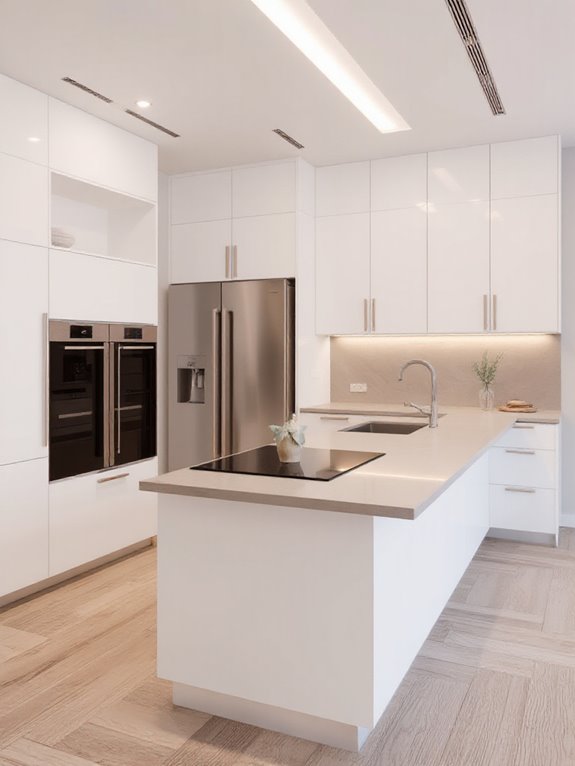
Incorporating hidden kitchen appliances has become a game-changer for maintaining both functionality and aesthetics in my space. I’ve installed custom cabinets that seamlessly conceal my microwave, blender, and toaster, keeping countertops clutter-free. Pull-out pantries now house my coffee maker and stand mixer, making them easy to access yet out of sight.
My refrigerator blends perfectly with the cabinetry for a sleek, unified look. Even my dishwasher is disguised behind panels matching my kitchen’s design.
This approach hasn’t only elevated the room’s visual appeal but also made it easier to clean and organize. Hidden appliances truly redefine modern kitchen efficiency.
Eco-Friendly Kitchen Materials
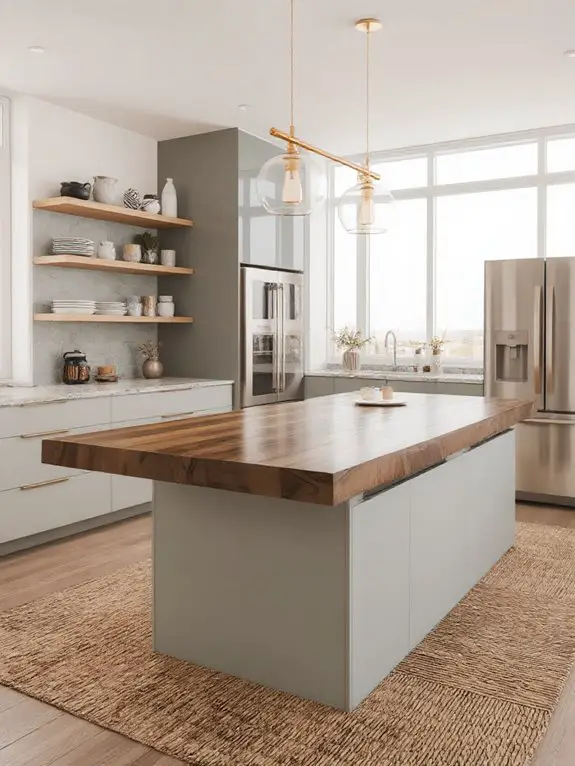
Shifting to eco-friendly kitchen materials has been transformative for both my space and my environmental impact. I’ve opted for sustainable options like bamboo for countertops and cabinets—it’s renewable, durable, and adds warmth to the design.
For flooring, I chose cork or reclaimed wood, which are both stylish and environmentally conscious. I also replaced plastic utensils with stainless steel or wooden alternatives.
Even my cleaning products are now biodegradable, reducing chemical waste. These changes haven’t just cut my carbon footprint; they’ve created a healthier, more natural kitchen vibe. It’s a small effort that makes a big difference in aligning my home with my values.
Vertical Kitchen Gardens
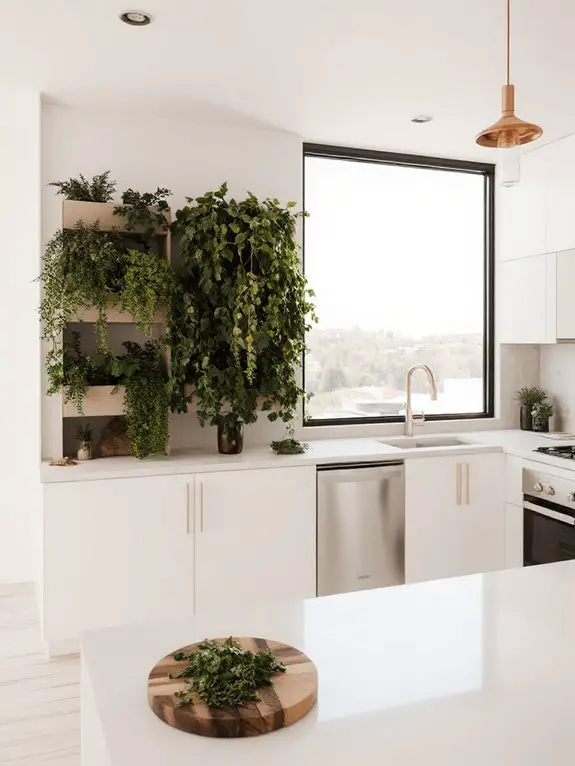
Vertical kitchen gardens have become a practical and stylish solution for adding fresh, homegrown produce to my cooking. I’ve found that installing wall-mounted planters or vertical shelving units maximizes space, especially in smaller kitchens. Herbs like basil, thyme, and mint thrive in these setups, and I love having them within arm’s reach while preparing meals.
I use self-watering systems to keep maintenance simple, and I opt for lightweight containers to avoid putting strain on walls. A vertical garden not only enhances the kitchen’s aesthetic but also guarantees I always have organic ingredients on hand, making my dishes fresher and more flavorful.
Matte Finish Cabinets and Surfaces
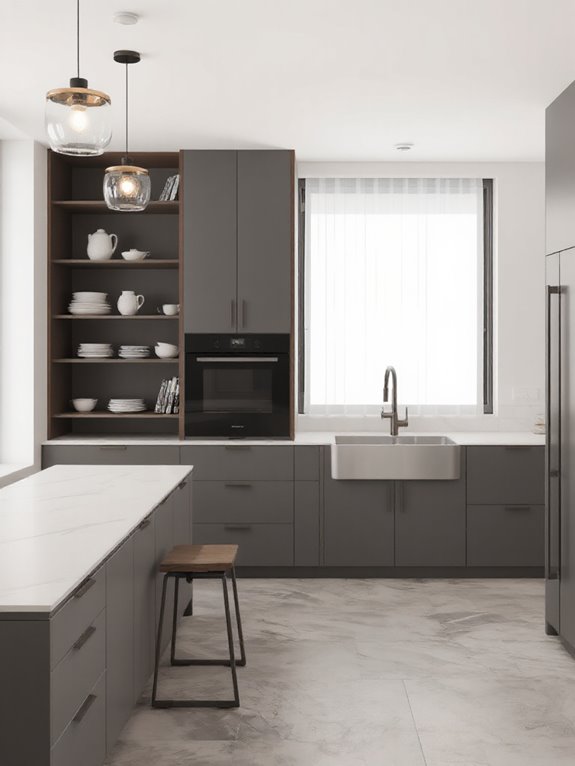
While matte finish cabinets and surfaces may seem understated, they’ve become a favorite choice for their ability to add sophistication and ease of maintenance to my kitchen. I love how they don’t show fingerprints or smudges as easily as glossy finishes, making them practical for busy households.
Their smooth, non-reflective texture creates a calming, modern aesthetic that pairs well with various styles, from minimal to industrial. I’ve found that lighter matte tones open up the space, while darker shades add depth and drama.
Plus, they’re durable and resistant to scratches, ensuring my kitchen stays looking polished with minimal effort.
High-Tech Kitchen Gadgets
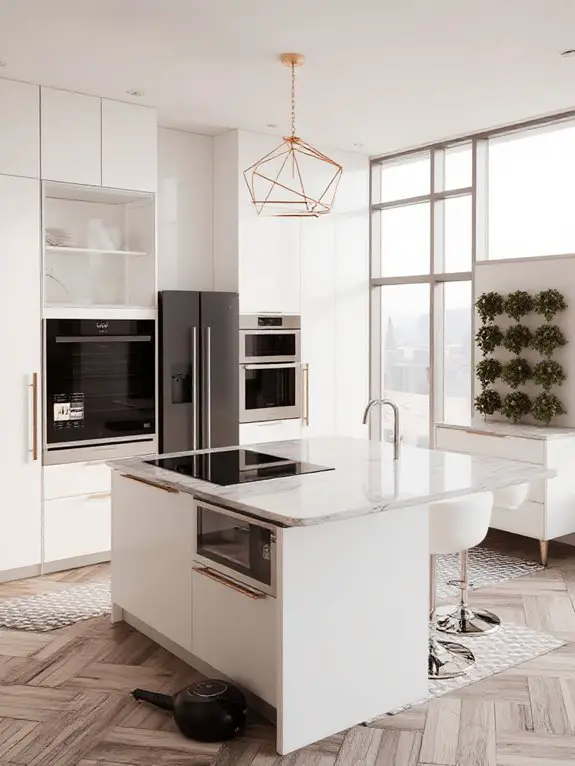
High-tech kitchen gadgets have transformed how I approach cooking, making tasks faster, easier, and more precise. Smart ovens with Wi-Fi connectivity let me control temperatures and cooking times from my phone, while sous vide machines guarantee perfectly cooked meats every time.
I rely on precision scales for baking accuracy and multi-functional food processors to chop, blend, and knead with minimal effort. Induction cooktops heat up instantly and save energy, and voice-activated assistants help me set timers or find recipes hands-free.
These tools not only streamline my workflow but also inspire me to experiment with new techniques and dishes confidently.
Scandinavian-Inspired Kitchen Aesthetics
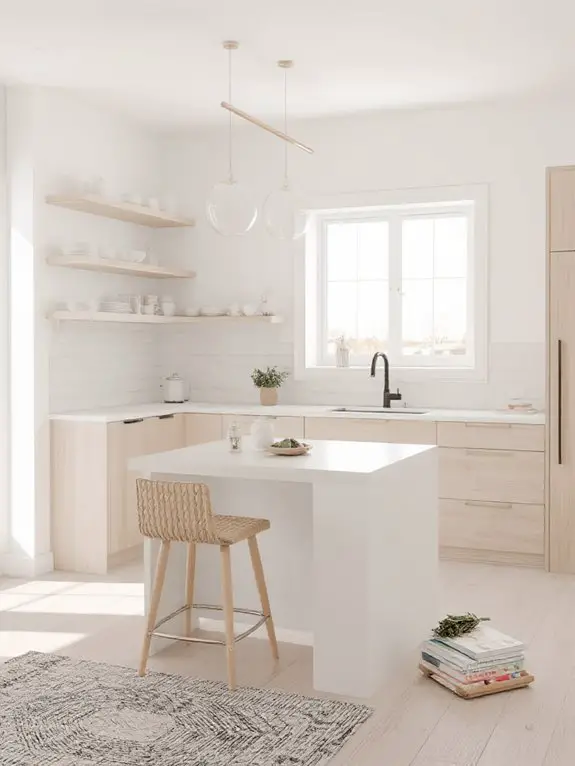
Though minimalist in design, Scandinavian-inspired kitchens prioritize warmth and functionality, creating spaces that feel both inviting and efficient. I love how they use light-colored woods like birch or ash, paired with crisp white walls, to amplify natural light.
Open shelving keeps essentials within reach while maintaining an airy feel. Adding soft textiles, like a wool rug or linen curtains, introduces texture without clutter.
The key is balancing simplicity with coziness—think understated hardware and clean lines complemented by warm lighting. I recommend sticking to a neutral palette with pops of muted tones, like sage or dusty blue, to keep the space serene yet personal.
Two-Tone Kitchen Designs
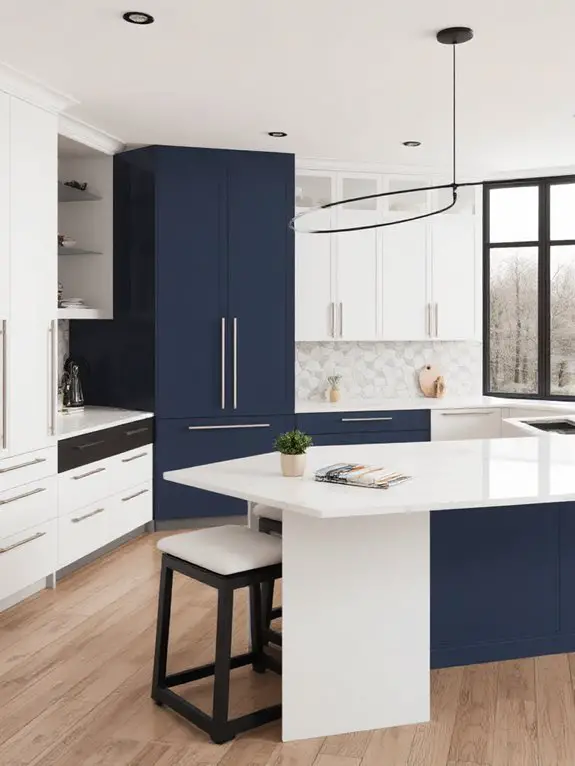
To create a dynamic yet cohesive kitchen, I often turn to two-tone designs, which offer versatility and visual interest. Pairing contrasting colors—like navy lowers with white uppers—adds depth without overwhelming the space.
I recommend balancing bold and neutral tones; a dark base grounds the room while lighter cabinets keep it airy. For a modern twist, try matte black with warm wood tones.
Don’t forget the island—painting it a different shade ties the look together. Finish with matching hardware for polish.
This approach lets you experiment with color while maintaining harmony, making your kitchen feel intentional and stylish.
Open Shelving With Minimal Decor
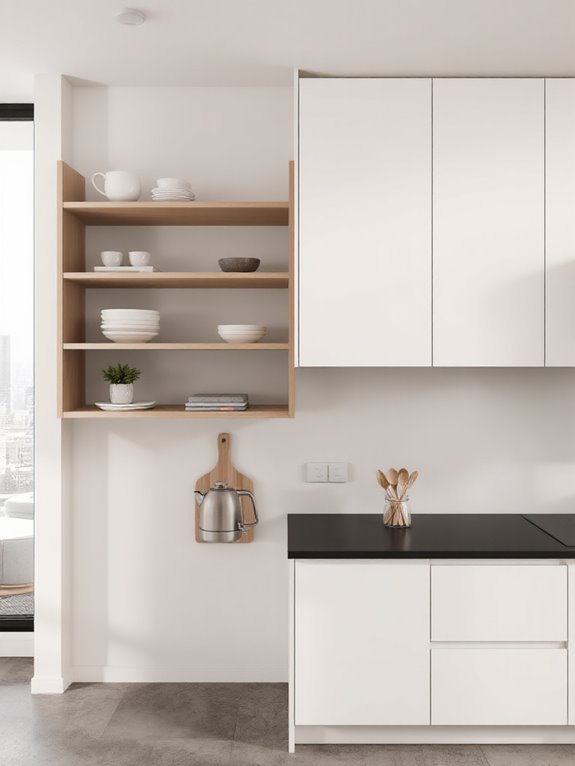
When designing a modern kitchen, open shelving paired with minimal decor can create a sleek, functional aesthetic. I like to focus on clean lines and uncluttered surfaces, using shelves to display a few carefully curated items like matching dishware, glass jars, or cookbooks.
This approach keeps the space airy while adding personality. I recommend opting for neutral tones or warm woods to maintain simplicity. Avoid overcrowding; less is more here.
Functional pieces, such as a small plant or sleek canisters, can enhance the look without overwhelming it. Open shelving not only looks modern but also makes essentials easily accessible.
Quartz and Marble Countertops
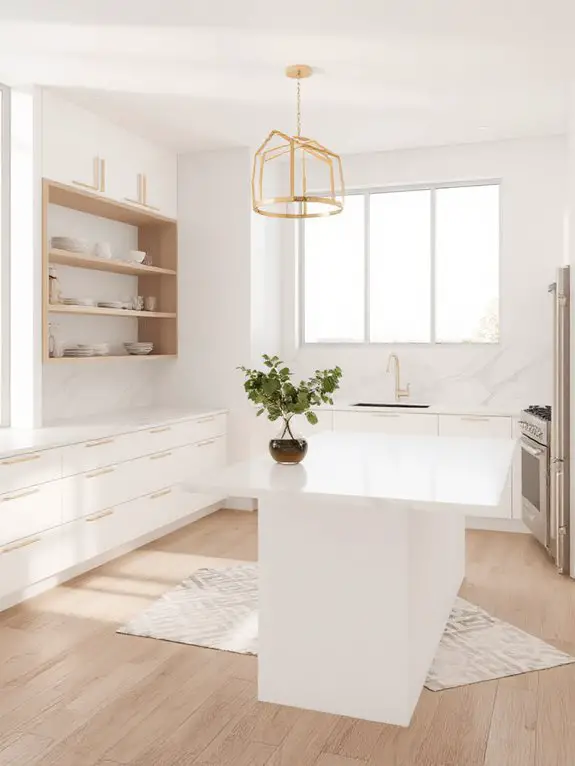
Because quartz and marble countertops are both stunning and practical, they’ve become staples in modern kitchens. I love how quartz offers durability and low maintenance, resisting stains and scratches effortlessly. It’s perfect for busy households.
Marble, on the other hand, brings unmatched elegance with its unique veining, though it requires more care to prevent etching and staining. I’d recommend sealing it regularly.
Both materials work well with sleek, modern designs, adding a polished finish. I’d suggest pairing them with neutral cabinetry for a timeless look. Whether you prioritize durability or luxury, these countertops elevate any kitchen’s aesthetic and functionality.
Seamless Indoor-Outdoor Kitchen Connections
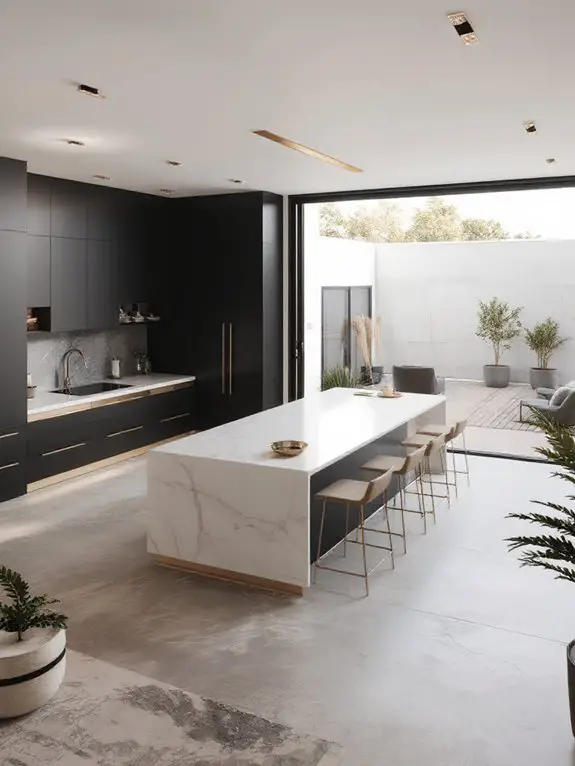
As outdoor living spaces become increasingly popular, creating a seamless connection between indoor and outdoor kitchens has transformed into a must-have feature for modern homes.
I focus on matching materials and finishes between both spaces to guarantee visual harmony, like using the same countertops or cabinetry. Installing large sliding or folding glass doors enhances accessibility and allows natural light to flow through.
I also recommend placing key appliances, like grills or pizza ovens, directly outside for convenience. Thoughtful lighting, such as pendant lights or string lights, ties the spaces together while providing functionality.
Finally, I prioritize weather-resistant materials to secure durability and longevity.
Frequently Asked Questions
What Is the Average Cost of a Kitchen Renovation?
“Ever wondered why kitchen renovations can vary so much in price? I’ve found the average cost ranges between $12,000 to $35,000, depending on materials, size, and labor. It’s really about balancing quality with your budget.”
How Long Does a Kitchen Remodel Typically Take?
I’d say a kitchen remodel typically takes 6 to 12 weeks, depending on the scope. If it’s a minor update, it might take 3 to 4 weeks, but major overhauls can stretch to several months if there are delays.
What Are the Best Kitchen Layouts for Small Spaces?
I’d recommend galley or L-shaped layouts for small kitchens, as they maximize efficiency without crowding. I’ve found that open shelving and multifunctional islands also help save space while keeping things functional and visually uncluttered.
How Do I Choose the Right Kitchen Contractor?
Did you know 60% of homeowners vet at least three contractors before hiring? I start by checking licenses, reading reviews, and asking for references. I also request detailed quotes to compare costs, timelines, and warranties before making my decision.
What Permits Are Needed for a Kitchen Renovation?
I’ll need to check local building codes, but generally, permits for electrical, plumbing, and structural changes are required. I’d consult my contractor or local building department to verify I’ve got all the necessary paperwork covered.

